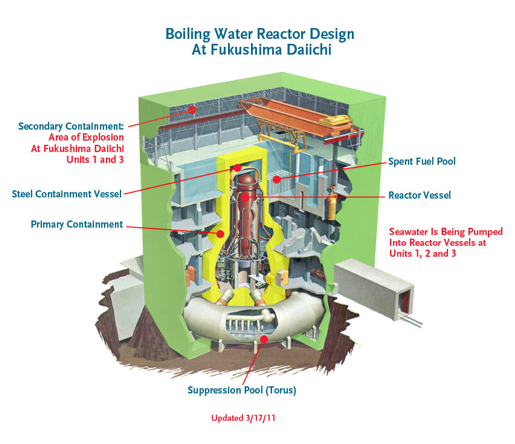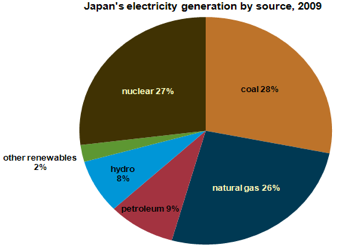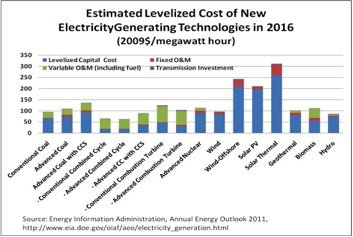The earthquake and tsunami that recently hit Japan knocked out the back-up power that runs the cooling system on several of Japan’s nuclear reactors, exposing fuel rods, and damaged components to several of the reactors. The Japanese have worked tediously to avoid a full meltdown by cooling the control rods with seawater from the Pacific Ocean and deploying helicopters and fire trucks to more effectively disperse water on the units. Japan’s reactors were tested to withstand an earthquake of a 7.9 magnitude. Unfortunately, the earthquake that struck last Friday was of a 9.0 magnitude.
Public concern over Japan’s nuclear accident has led China to review the safety of its operating and proposed nuclear units. The country has suspended approvals for new nuclear plants to revise its safety standards and has asked for safety checks at their six operating nuclear plants. With China’s GDP growing at 7 to 10 percent, its energy requirements are enormous. The country is undertaking construction of all types of electricity generators—coal, nuclear, natural gas, hydroelectric, wind and solar—to fuel its growing economy. Nuclear power and renewable energy generating plants play a major role in China’s plan to reduce carbon intensity.
Germany’s Chancellor Angela Merkel has ordered the temporary shutdown of almost half of its 17 nuclear reactors for 3 months. The shutdown affects reactors built prior to 1980. The shut down announcement had an effect on futures contracts for electricity prices bidding them up by 6 percent, and has businesses wondering where the energy will come from to replace the electricity generated by those reactors, which supply 5 percent of the nation’s electricity. Merkel’s administration had previously approved a life extension on the country’s nuclear plants, extending them on average by about 12 years. Merkel stated that “German nuclear power plants are among the safest in the world.” She indicated that a nuclear power withdrawal should be “with a sense of proportion.”
For the European Union, nuclear safety tests are voluntary. While some countries in the union would like to phase out nuclear, others such as France and Britain are defending the technology. France generates about 80 percent of its electricity from nuclear power and exports the technology, while Britain generates about 18 percent of its electricity from nuclear.
And in the United States, President Obama has asked for a comprehensive, safety review of all nuclear reactors. Nuclear Regulatory Commission (NRC) Chairman Gregory B. Jaczko indicated that the safety review would be done in two phases. First, a 90-day short-term review would be done of the nuclear reactor fleet in the United States, followed by a longer-term, comprehensive review based on Japan’s report of findings.
Japan’s Nuclear Accident
The earthquake that hit Japan registered 9.0 on the Richter scale, making it the largest earthquake in Japan in 300 years, and was followed by a number of smaller quakes. The quake and resulting tsunami have caused thousands of deaths and damage. Japan has several nuclear plants along its northeastern coast where a number of units were placed under a state of emergency at three different plants–Fukushima Dai-ichi, Fukushima Daini and Onagawa, but the worst problems seem to be at the Dai-ichi units.
At several of the Dai-ichi units, the diesel generators that provide electricity to cool the reactors failed, causing the water to overheat and evaporate, releasing some radioactive steam, which dissipates into the atmosphere. If the water evaporates to a level below the rods, a meltdown can result, where the control rods melt to the bottom of the containment vessel due to the high temperatures that occur when the control rods are not adequately cooled. To Japan’s credit they have used an emergency cooling system and sea water to cool the reactor rods in several of the reactors where the original cooling system failed. Because the cooling water is a mixture of seawater containing salt and boric acid, it is corrosive to the units and can destroy the reactors from further use.

Besides the problem with the cooling system, some officials fear that the primary containment vessel to one of the reactors was damaged, and that another had structural damage to the building shell. A fourth unit that was offline when the tsunami hit may have lost cooling water in the pool above the containment vessel where the spent fuel rods are stored when they no longer provide enough heat to generate electricity. Unlike the primary containment vessel that is encased in steel, the spent fuel rods are shielded by concrete.
Exposing the fuel rods increases the temperature of the rods and can quicken the path to a meltdown. A meltdown occurs when a reactor’s radioactive core, which holds its uranium fuel, gets so hot that it begins to melt. A complete meltdown can breach a reactor’s steel containment vessel and spread radioactive byproducts into the atmosphere. In a partial meltdown, the control rods may be damaged or cracked due to being exposed without sufficient cooling water, releasing radioactive elements. The difference between a partial and full meltdown is enormous.
It can take years before a partial meltdown is known as was the case with Three Mile Island in 1979, where robotic cameras determined that a meltdown had occurred. Because Japan’s nuclear reactors are incased in a thick layer of steel and concrete, it is hoped that should a meltdown occur, it would be contained within the reactor’s vessel unlike the meltdown that occurred in 1986 at Chernobyl, which did not have a containment structure. According to Andre-Claude Lacoste, president of ASN nuclear safety authority in France, regarding Japan’s accident, “It’s clear we are at Level 6, that’s to say we’re at a level in between what happened at Three Mile Island and Chernobyl.” On March 18, Japanese officials, however, raised their assessment of the severity level of the nuclear accident to 5, up from level 4, on the International Nuclear Event Scale.
On Saturday, March 20, events in Japan somewhat stabilized since there were no new explosions and no new fires at the troubled Dai-ichi units. However, radiation levels within the Daiichi plant remained high; limiting the amount of time workers could spend at the facility in their efforts to attach an electrical line to get the cooling system functioning again. Unfortunately, Japan’s ordeal is not over for its nuclear industry since smoke was seen coming from two of the reactors on Monday, March 21, 10 days after the accident occurred, and the water in the vessel holding the spent fuel rods was still boiling. Reestablishing electrical lines is the key to the stabilization of the reactors to get the cooling system operational. Japanese Prime Minister Kan said in a nationally televised address Friday, March 19, the Japanese people “are being tested. We must not be discouraged by this earthquake and tsunami. Let us confront this crisis together, with determination that we will once again rebuild Japan.”
Japan generates about 30 percent of its electricity from 54 nuclear reactors with a total capacity of 49 gigawatts. The country ranks third in the world in nuclear energy consumption, after the United States and France. With about a dozen reactors shut down and some of those destroyed, the country not only has problems in dealing with the destruction caused by the quake and the tsunami, but also in getting power to its population who are dealing with near-freezing temperatures.
Source: U.S. Energy Information Administration – International Energy Agency
U.S. Government Reaction
NRC Chairman Gregory B. Jaczko indicated that U.S. territories in the Pacific Ocean, Hawaii and West Coast states are safe from radiation from Japan’s damaged nuclear reactors, because of their distance from those nuclear units and the likelihood of any radiation dissipating over the Pacific Ocean. The NRC Chairman also indicated that U.S. nuclear reactors are adequately designed to withstand earthquakes and tsunami impacts, but that the Commission will review information from Japan’s accident for potential modifications to safety requirements for nuclear units in the United States. On Sunday, March 20, Jaczko said that the spent fuel pools at American nuclear reactors are less vulnerable than the ones in Japan because of safety steps taken after the attacks of Sept. 11, 2001, including setting up procedures; locating emergency generators, diesel-driven pumps, hoses and diesel fuel; and the use of fire hoses to pump in extra water in the event ordinary cooling systems are knocked out.
The United States has 23 reactors similar to those of Japan. Each of those reactors was designed specifically for their site location and the back-up generators that handle their cooling systems are housed in separate buildings with watertight fittings to keep out water from hurricanes and floods. Japan’s back-up generators were stored in the basement and were easily swamped when the tsunami hit. In the United States, nuclear reactors are required to have redundant systems to ensure that a loss of power will not harm their ability to cool the spent fuel pools.
Secretary of Energy Steven Chu told the House Appropriations Energy and Water Development subcommittee, “Nuclear energy has an important role to play in our energy portfolio. The American people should have full confidence that the United States has rigorous safety regulations in place to ensure that our nuclear power is generated safely and responsibly. Information is still coming in about the events unfolding in Japan, but the Administration is committed to learning from Japan’s experience as we work to continue to strengthen America’s nuclear industry.” And on Sunday, March 20, Chu said the 23 American reactors that use the same Mark 1 design as was used in the Daiichi Nuclear Power Station “are constantly being upgraded” to improve their safety.
On Thursday, March 17, President Obama called for a comprehensive, safety review of all domestic nuclear plants, and reiterated that radiation from Japan’s damaged nuclear units would not reach the United States or its territories in harmful levels. NRC Chairman Jaczko has announced a two-phase safety review—a 90-day review followed by a comprehensive review based on Japan’s report of what actually occurred.
China’s Nuclear Construction Program
China currently has 10.8 gigawatts of nuclear capacity operating, and has about 28 nuclear reactors under construction. Based on China’s 5-year plan, they intend to have 40 gigawatts of nuclear power by 2015, and estimates have China’s nuclear reactors totaling 70 to 100 gigawatts by 2020. By 2030 they want to generate more power from nuclear energy than the United States generates from its 104 nuclear units.
Zhang Lijun told reporters Saturday, March 12, “Up to now we are paying attention to the impact of the earthquake on Japan’s nuclear equipment and we are paying attention to how the situation develops.” But he also indicated that Japan’s nuclear accident would not deter China from building nuclear power plants. On Sunday, March 13, Xie Zhenghua, vice chairman of China’s National Development and Reform Commission, said, “Evaluation of nuclear safety and the monitoring of plants will be definitely strengthened.” But with the public nervous about the ongoing developments regarding the nuclear units in Japan, China’s State Council “has suspended the approval process for nuclear-power stations so that safety standards can be revised after the explosion at a Japanese plant.”
China is currently building Westinghouse AP1000 reactors that are still undergoing approval in the United States in Haiyang and Sanmen and European generation III reactors in the Guangdong province with the help of France’s Areva. The problem of using diesel generators to pump cooling water into the reactors has been fixed in the design of advanced nuclear units. The AP in Westinghouse’s AP1000 name stands for “Advanced passive”. It is a generation III technology, and uses a passive cooling system where water circulates by natural convection instead of needing electricity to pump the cooling water. China builds these generation III reactors at lower cost than the United States because of less red tape, state-owned financing, and low cost labor familiar with large infrastructure projects.
Technology Costs for New Nuclear Capacity
For new construction, nuclear energy is still a more expensive technology than new fossil fuel generating technologies and some renewable technologies. The Energy Information Administration publishes the cost of generating technologies in the United States on an annualized basis per kilowatt-hour of output so that those costs can be compared across technologies. On average, advanced nuclear technologies are over 70 percent more expensive than natural gas combined cycle units and 20 percent more expensive than a pulverized coal unit. It should be noted that these costs assume our current regulatory environment. In contrast, the Chinese can build nuclear power generation for about half of the cost of nuclear construction in the United States, in part because of the difference in Chinese and U.S. regulatory environments.
While nuclear power is more costly than coal-fired and natural gas-fired technologies, it represents a carbon-free source of electricity. If carbon dioxide is priced because of a carbon tax or as a result of a cap and trade policy, modeling results show that nuclear energy makes a comeback as a major base-load generating technology and keeps electricity prices from escalating more than otherwise once carbon emitting technologies are excluded from electric utility portfolios. In fact, EPA’s modeling of the Waxman-Markey cap and trade bill assumed that 100 new nuclear plants were built by 2050 to provide enough carbon-dioxide free electricity generation.
Conclusion
Japan’s reactors are mostly generation II reactors that lack the additional safety features of today’s generation III reactors. The nuclear industry in its design of third generation nuclear units has dealt with the back-up generators that operate the cooling system by using natural convection to circulate the water. While nuclear power is a more expensive technology than its fossil fuel competitors for new construction, unlike fossil fuels, it can serve as a source of base-load power in a carbon reduction scenario where most renewable technologies cannot compete.
The purpose of this article is not to advocate nuclear power as a source of electricity generation. All fuels and technologies have problems such as fish kills for hydro power, noise pollution and bird kills for wind which doesn’t blow all the time, large land mass requirements for solar which is also very expensive and sporadic power source, rig explosions for oil, and mining accidents for coal, to name a few. To have sufficient energy for the future and to continue our standard of living, we will need access to all of sources of energy. We believe that nuclear power, as well as all other technologies, should compete in the market place without subsidies or other federal and state interventions.





